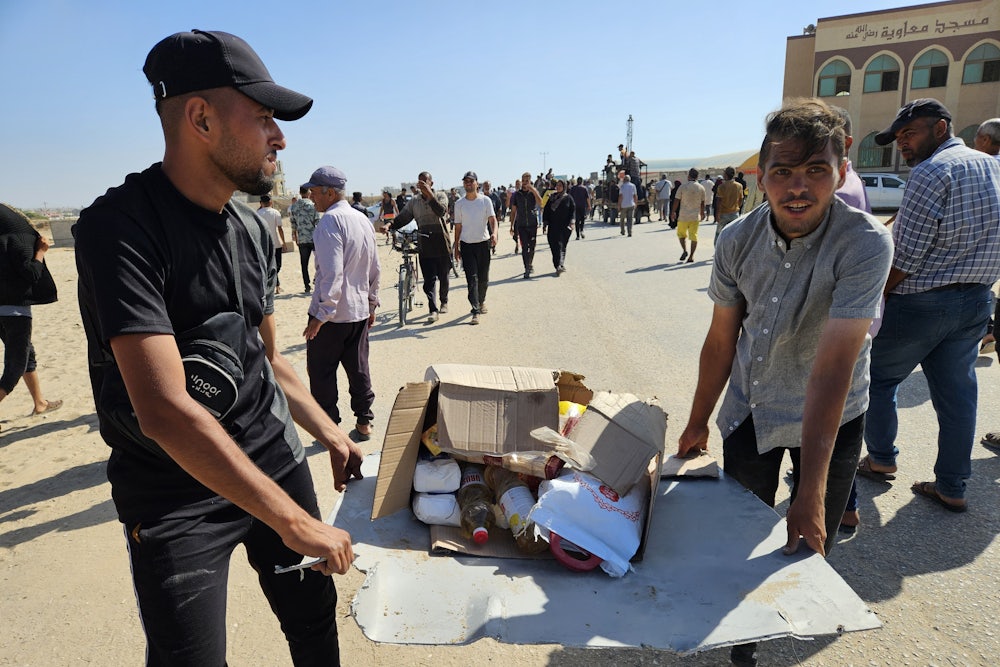Gaza has endured 11 weeks of a blockade so total it lacks any precedent in modern history. The world has not seen urban hunger this desperate and extreme since the siege of Leningrad ended in 1944.
Eleven weeks. Bones started showing through skin. Children were whittled down to a few kilograms, to limp handfuls. Worms found the last sacks of flour before the people did. The dogs that grew fat during the first phase of the war by feeding on the uncounted dead turned haggard again. Six-month-old Siwar Ashour looked with watery eyes out from the gray pit of a man-made hell—the only world she has ever known—too young to know why her belly is distended like that, too young to understand why she has the skin of an old woman. And for 11 weeks, the elites of the Western world looked back into Siwar’s eyes (if they could even be bothered doing that) and said: Yes, she too should not be allowed to live.
At the moment of absolute crisis, when the Integrated Food Security Phase Classification’s starvation maps were shaded completely red—the worst moment yet in 19 months of war—it appears as if Israel and the United States have finally yielded. The new plan to allow food into Gaza might look like relief, might look like a change of heart—a reluctant gesture that Siwar Ashour doesn’t deserve to be punished for the accident of her birth or for the crimes made by men a full year before she was conceived.
But in truth, this new “humanitarian” regime is not benevolent, fair, or equal, nor the heartbroken sympathy of the world for a people on the very brink of annihilation. It is a new phase in that annihilation, an instrument of Israeli policy to further dominate the Palestinians of Gaza, to more tightly restrict their calories and their movement. On Tuesday, this new phase began with the Israel Defense Forces blindly shooting at several thousand starved people who refused to wait patiently for the bread that is their right, killing three. It was no accident.
The new aid system is run by the Gaza Humanitarian Foundation, or GHF. Its governance is a cloaked nexus of shell holdings, Swiss entities, escaped crooks, and U.S. military veterans—without a single Palestinian (or Arab) voice allowed to provide even nonbinding advice. Its plan is to operate four “Secure Distribution Sites”: armoured citadels defended by a private security company (another shadowy shell outfit called Safe Reach Solutions). The foundation proudly admits that each of these hubs can feed 300,000 people. But this is only half of Gaza’s prewar population. Even if GHF’s board promises to expand its capacity, one million Palestinians would still be starving, still without safe drinking water, still lacking even the simplest means of hygiene like toilet paper and tampons.
Israel has engineered this new system so the greater mass of Gazans will be more concentrated, simpler to spy on, and easier to control. Security cameras and biometric testing are planned to screen the needy. Importantly for the greater designs of the Israeli government, large areas of the Gaza Strip can be depopulated, ripe for the “conquest” the war cabinet approved earlier this month. And with only a handful of aid hubs to monitor, it saves the IDF the hassle of bombing each node of the old network individually, as it did when it flattened a U.N. distribution centre in Jabalia on May 9. It was, of course, empty. All the warehouses are empty.
While GHF might proclaim its “strict adherence to humanitarian principles … ensuring assistance reaches those most in need, without diversion or delay,” it is still beholden to its patron. During a hearing of the Knesset’s Foreign Affairs and Security Committee, Prime Minister Benjamin Netanyahu insisted that aid would in fact be “conditional”—only those Palestinians who promise not to return to their homes in areas declared off-limits by the IDF can be eligible. The destitute must run the gauntlet south, over the Netzarim and Morag corridors, kettled and corralled into tiny areas around the “Secure Distribution Sites” to become utterly dependent on handouts. It also means concentrating men specifically, who are more likely to walk the long distances and then carry a heavy box all the way back. Their new homes will be hunger camps.
The first “Secure Distribution Site” proved to be anything but “secure.” On May 27, the mass of Palestinians who came south—toward Rafah, a city that no longer exists—found a 20-acre plot of earth with sand walls, squat watchtowers, and a staff incapable of controlling a desperate population, even with the help of a labyrinth of wire fences and steel gates. The fences were busted down, the GHF’s staff retreated, and the IDF picked up the slack. Three Palestinians were killed and several dozen others injured in a spree of gunfire. Of course, some of the meager supplies—beans, pasta, lentils—are produced in Israel, with Hebrew branding. War is a racket, Smedley Butler once said. Someone along the chain is making a killing from killing.
Who is that someone? Even before its disastrous debut, the GHF seemed to empty itself of personnel, either out of shame or embarrassment. Jacob Wood, formerly of the aid group Team Rubicon, resigned his post as executive director, saying it was “not possible to implement this plan while also strictly adhering to … humanitarian principles.” Nate Mook, the former CEO of World Central Kitchen, denied being a part of the GHF, even though his name appeared on early memos leaked to the press. Ex-South Carolina governor and longtime chief of the U.N.’s World Food Programme David Beasley was the foundation’s best chance at appearing legitimate or impartial. His name too appeared in the briefing documents. He has wisely kept quiet.
It has long been the Israeli government’s desire that Gaza’s economy should be utterly dependent on the largesse of their occupiers. Even before the war, 80 percent of the population needed some kind of humanitarian assistance to get by. Since 2007, according to a leaked U.S. diplomatic cable, Israel has kept the Strip “functioning at the lowest level possible consistent with avoiding a humanitarian crisis.” And since October 7, the Israeli army has deliberately wrecked four-fifths of Gaza’s agricultural land, which in the best of times could only feed a third of its people.
Now there will not be a country. It is extremely rare for Netanyahu to say openly what is being done to Gaza and its population. For 19 months, Israel’s prime minister stayed on message—get the hostages, finish off Hamas—while deferring the bloody work of honesty to his deputies. Yet at the same Knesset committee, Netanyahu proudly admitted his true intent. “We are demolishing more and more homes,” he said. The Palestinians “have nowhere to return. The obvious result will be the desire of Gazans to emigrate outside the Strip.” In this sense, the Gaza Humanitarian Foundation and Israel’s newest government agency—the Voluntary Emigration Bureau—go hand-in-hand. They are the two tracks of a single strategy, the pincers advancing toward a clear goal: to get as many Palestinians as possible to leave their homeland and never come back.
Because the GHF’s aid regime is a naked instrument of Israeli policy, the U.N.’s relief agencies and other charities have unanimously rejected taking part in it. Their reasons are sound. Publicly they condemn any plan, as U.N. Secretary General António Guterres put it, that would risk “further controlling and callously limiting aid down to the last calorie and grain of flour.” Privately they fear becoming complicit in a vast crime. Indeed, the worst crime of our age. “The model of total control over aid delivery and distribution exercised by a party to the conflict,” a U.N. discussion memo says, “would become a standard that other Member States may seek to replicate.” Israel is setting a standard, a precedent. The methods of annihilation trialed here can be trialed elsewhere—will be trialed elsewhere. Anyone refusing to oblige or consent now is doing a favor to the future.
Take the long view. Look from above. What do we see? Not just a nation being dismantled, piece by gory piece. Not just the Israeli government’s shameless perpetration of nearly every one of the gravest crimes humanity has written. We see exactly the techniques a sadist might use to make their captive helpless and pliable. The unrelenting airstrikes. The unceasing demolition of homes and farmland. The unnerving assassinations of journalists and aid workers. Above all, the use of hunger as a weapon of coercion. There is a word for what Israel is doing: torture—the torture of an entire society in the hope it might flee its torment or perish in the trying. The Gaza Humanitarian Foundation cannot rescue the Palestinians. It is one more tool in a suite of destruction.




